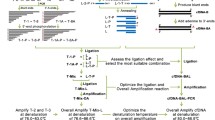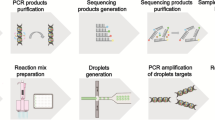Abstract
Purpose: We evaluated methods of preparation of DNA from single cells for amplification and preimplantation genetic diagnosis (PGD), including our “spanning protocol.”
Methods: Dystrophin gene exons 45 and 51 were amplified by nested polymerase chain reaction (PCR) from a single lymphocyte or blastomere. Amplification efficiencies were compared between DNA extraction by (A) lysis in distilled water with freeze-thawing and boiling; (B) two-step lysis involving potassium hydroxide and dithiothreitol; and (C) the spanning protocol, using N-lauroylsarcosine.
Results: With method A, amplification efficiency was 66/120 (55%) and false-positive such as amplification failure or allele drop out was 42/120 (35%); with B, 96/120 (80%) and 21/120 (17.5%); and with C, 111/120 (92%) and 5/120 (4.2%), using single blastomeres and unaffected lymphocytes from male. Occurrence of false-negative such as contamination of another DNA with method A was 4/120 (3.3%); with B, 10/120 (8.3%); and with C, 2/120 (1.7%) from using single lymphocytes from affected males.
Conclusion: The spanning protocol was most efficient for extracting DNA from a single cell and should be particularly useful for preimplantation genetic diagnosis.
Similar content being viewed by others
References
Hardy K, Winston RM, Handyside AH, et al.: Biopsy of cleavage-stage human embryos and diagnosis of single-gene defects by DNA amplification. Arch Pathol Lab Med 1992;116:388–392
Verlinsky Y, Kuliev AM: Preimplantation diagnosis of genetic disease: A new technique in assisted reproduction. New York, Wiley-Liss, 1993
Kontogianni EH, Griffin DK, Handyside AH: Identifying the sex of human preimplantation embryos in X-linked disease: Amplification efficiency of Y-specific alphoid repeat from single blastomeres with two lysis protocols. J Assist Reprod Genet 1996;13:125–132
Hardy K, Martin KL, Leese HJ, et al.: Human preimplatation development in vitro is not adversely affected by biopsy at the 8-cell stage. Hum Reprod 1990;5:708–714
Verlinsky Y, Handyside A, Grifo J, et al.: Preimplantation diagnosis of genetic and chromosomal disorders. J Assist Reprod Genet 1993;11:236–243
Hashiba T, Sueoka K, Kuroshima H, et al.: An accurate and rapid gender determination assay in single cells by the capillary polymerase chain reaction method. J Assist Reprod Genet 1999;16:551–554
Hashiba T, Sueoka K, Kuroshima H, et al.: Accurate multiplex polymerase chain reaction assay for gender determination from a single cell. Gynecol Obstet Invest 2000;49:217–220
Handyside AH, Kontogianni EH: DNA amplification of Y-specific sequences for sexing preimplantation human embryos. In Preimplantation genetics, Y Verlinsky, C Strom (eds), New York, Plenum Press, 1991
Kontogianni EH, Hardy K, Handyside AH: Co-amplification of X- and Y-specific sequences for sexing preimplantation human embryos. In Preimplantation genetics, Y Verlinsky, C Strom (eds), New York, Plenum Press, 1991
Handyside AH, Kontogianni EH, Handy K, et al.: Pregnancies from biopsied human preimplantation embryos sexed by Y-specific DNA amplification. Nature 1990;344:768–770
Grifo JA, Tang YX, Munne S, et al.: Healthy deliveries from biopsied human embryos. Hum Reprod 1994;9:912–916
Griffin DK, Wilton LJ, Handyside AH, et al.: Dual fluorescent in situ hybridisation for simultaneous detection of X and Y chromosome specific probes for the sexing of human preimplantation embryonic nuclei. Hum Genet 1992;89:18–22
Griffin DK, Wilton LJ, Handyside AH, et al.: Diagnosis of sex in preimplantation embryos by fluorescent in situ hybridisation. BMJ 1993;306:1382
Hardy K, Winston RML, Handyside AH: Binucleate blastomeres in human preimplantation embryos in vitro: Failure of cytokinesis during early cleavage. J Reprod Fertil 1993;98:549–558
Grifo JA, Tang YX, Cohen J, et al.: Pregnancy after embryo biopsy and coamplification of DNA from X and Y chromosomes. JAMA 1992;268:727–729
Handyside AH, Harper J, Winston RML: Preliminary evaluation of the use of in vitro fertilization for preimplantation diagnosis of inherited disease. J Reprod Fertil Abstr Ser 1992;10:53
Girardet A, Catha P, Clavstres M: Montpellier: Rapid detection of the F508 mutation in single cells using DHPLC: Implications for preimplantation genetic diagnosis. J Assist Reprod Genet 2003;20:153–156
Author information
Authors and Affiliations
Corresponding author
Rights and permissions
About this article
Cite this article
Tsuchiya, S., Sueoka, K., Matsuda, N. et al. The “Spanning Protocol”: A new DNA extraction method for efficient single-cell genetic diagnosis. J Assist Reprod Genet 22, 407–414 (2005). https://doi.org/10.1007/s10815-005-7482-x
Received:
Accepted:
Issue Date:
DOI: https://doi.org/10.1007/s10815-005-7482-x




